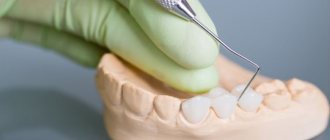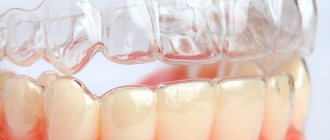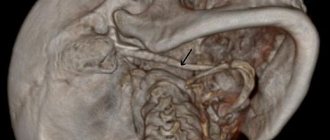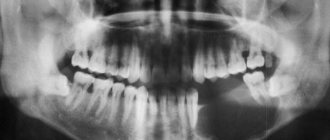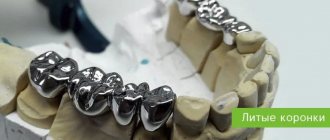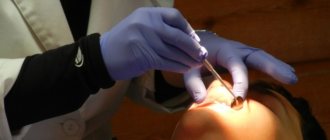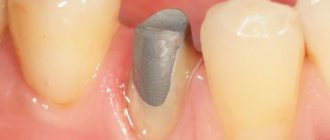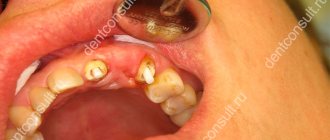The inlay is a one-piece structure, the lower part of which is similar to a stump (therefore a stump). It takes into account the characteristics of the destroyed tooth, so it can be single, double or triple. In complex cases, it may consist of individual elements. The upper part is made of any shape, in accordance with the impression taken. The inlay can be installed without a crown, completely repeating the shape of the tooth. Such microprosthetics are often used in orthopedic dentistry, because even a severely damaged tooth can be completely restored, obtaining an aesthetic dental unit.
Advantages and disadvantages of tabs
- There is no danger of destruction or cracking - the strength and reliability of the inlays is high.
- Resistance to food dyes, color stability.
- The characteristics of the bite are taken into account.
- The shape of the tooth is completely restored and remains unchanged in the future.
- There are no unpleasant sensations at all.
- The result of tooth restoration is highly aesthetic.
- The possibility of the spread of harmful organisms is eliminated.
Negative aspects may arise if you go to clinics with insufficient equipment or inflated prices. In these cases, patients note the lengthy process of manufacturing and installing the inlay and the high cost.
Indications and contraindications for use
It’s worth putting a tab if there is:
- Extensive caries damage (more than 60%) of the tooth tissue;
- Large cavity size;
- Traumatic tooth damage;
- Hyperplasia, dysplasia;
- Wedge-shaped defect;
- The need for protection against tooth wear;
- Installation of bridges simultaneously with root structures.
The use of inlays is not recommended if the patient has:
- Small tooth cavity;
- Carious processes are active;
- There is no quality oral hygiene.
Reconstruction of the functionality of the dentition using an inlay allows you to cope with high loads. This is a great solution, but it can be painful some time after installation. What to do if a tooth hurts under the tab?
The cause of pain may be high sensitivity. If the situation worsens over time, you need to see a dentist and get an x-ray.
If a tooth hurts under the stump tab, then the following reasons are possible.
- Pulpitis is damage to the pulp of a tooth with a preserved nerve. When installing the inlay, the pulp chamber was accidentally damaged. After the anesthesia wears off, the pain becomes severe and intensifies with chewing and contact with cold and warm foods. The patient feels pain under the tab.
- Pressing the inlay into the tooth tissue. A bursting, aching pain occurs, which does not allow establishing a specific location.
- The tab is too large. The patient feels pain only when chewing. The pain is dull, there is no reaction to hot and cold food. The sensations are more like discomfort. In the absence of correction, inflammation of the periodontium or gums develops.
- Infection. Before installing the inlay, the doctor cleans the carious cavity to prevent further spread of the destructive process. If at this moment there is already an infection in the tooth, but has not yet been identified externally, after installing the tab the process will spread deeper, to the pulp and to the roots. If left untreated, the pain under the ceramic inlay will become very severe, the nature of the “sensations” will be pulsating and sharp.
What to do if the tooth under the crown hurts?
Orthopedic treatment in dentistry is a complex process that includes many stages. Every action during prosthetics requires professionalism and skills from the doctor. But, unfortunately, sometimes after fixing the prosthesis, the tooth under the structure may become ill. What to do in such a situation?
What to do if the tooth under the crown hurts.
If your tooth hurts immediately after installing a crown, then don’t panic. Such pains
may be a variant of the norm, since the oral cavity is only adapting to the new design. The pain after fixing the prosthesis will go away on its own in 2-3 days. If the pain does not subside, this is a serious reason to contact a specialist again.
But what to do if the crown has been in the mouth for a long time, and the tooth is just starting to hurt? In such cases, you should immediately contact your dentist, because most likely the tooth needs treatment.
Why does the tooth under the crown hurt?
Pain in a tooth under a crown can occur for a number of reasons.
In most cases, before fixing the crown in the tooth, the nerve is removed and the root canals are filled. In this situation, pain may appear for the following reasons:
- Incomplete filling of root canals. If after canal treatment the images show areas without filling material, then the canal is poorly sealed. Over time, this condition can lead to the development of an infectious process at the apex of the tooth roots. This situation occurs especially often in teeth with root canals that are too narrow and curved.
- Removal of filling material beyond the root apex. In this situation, there is too much material in the channel. “Extra” material enters the periodontal space and causes inflammation there, which is accompanied by pain.
- Shrinkage of materials over time. If endodontic treatment was performed many years ago, then there is a possibility that voids have formed in the root canals, which can cause pain.
- Perforation of the canal wall. This is a complication after canal treatment, which is the appearance of a hole in the canal cavity. Such a cavity can cause inflammation and pain.
- Breakage of the tool in the channel during processing. Various small tools can also trigger inflammatory reactions and pain.
In cases where a crown is fixed to a “living” tooth, the following circumstances most often become the causes of pain:
- Development of various forms of pulpitis on natural tooth tissues.
- Burn of the pulp (dental nerve) during the treatment of tooth tissue.
- Incomplete removal of carious tissue before fixing the crown.
In addition, pain in the tooth under the crown may occur for other reasons that do not depend on the treatment tactics before fixation, for example:
- Injury to the gums by the edge of the crown.
- A large amount of plaque in the mouth.
- Development of pathological periodontal pockets in the area of the prosthesis design.
- The appearance of a fistula under the crown.
- Poor fitting and fixation of the crown.
- Overbite overbite with an artificial crown.
- The appearance of mobility in a tooth with a crown.
There are other situations in which the tooth under the crown may hurt.
Only a dentist can find out the real cause of pain, as well as eliminate all unpleasant symptoms. You can make an appointment with a specialist at the dental clinic “Dentist” by calling
:
+7
+7(903) 961-85-87
Symptoms of inflammation of the tooth under the crown.
Inflammation of a tooth under an artificial crown is a serious dental problem, which may be accompanied by the following symptoms:
- Constant severe pain in the tooth indicates the development of acute periodontitis.
- Pain that appears when biting on a tooth is a sign of exacerbation of chronic periodontitis.
- Spontaneous pain with pain-free intervals is a symptom of tooth pulpitis (in cases where a “living” tooth is covered with a crown).
- Inflammation of the gums under the crown indicates the appearance of gingivitis or periodontal disease. This situation can arise when the gums are injured by the edge of the crown.
- The appearance of flux on the gum under the crown is a symptom of chronic periodontitis.
Of course, it is impossible to establish a diagnosis based on complaints alone. Therefore, after a conversation and examination of the oral cavity, the dentist will conduct an x-ray examination. It is the image that will help determine the pathology and draw up the correct treatment plan.
Relieving pain at home.
“The tooth under the crown hurts – what should I do?” — most patients ask this very question. Applying lard to a sore tooth, rinsing the mouth with herbal decoctions, chewing garlic and other folk recipes will not relieve a person from toothache.
What exactly cannot be done if the tooth under the crown hurts?
- Warm the area of inflammation. An increase in temperature in the area of the diseased tooth will lead to increased proliferation of microbes and increased inflammation.
- Take antibacterial medications unless prescribed by your dentist. Uncontrolled use of antibiotics will not only not save you from inflammation, but can also worsen your overall health.
- Try to unfix the crown yourself. If you remove it yourself, you can injure the hard tissues of the tooth, as well as damage the artificial structure.
- Take a horizontal position. Lying down will make the toothache worse.
Experts unanimously say that in order to relieve symptoms, it is important to treat the cause of their occurrence with a dentist. But some patients are so afraid of people in white coats that they do not lose hope and look for traditional recipes for toothache on the Internet, wasting precious time and aggravating the situation. Unfortunately, toothache does not go away on its own.
So, if the tooth under the crown begins to hurt, you should immediately make an appointment with the dentist. To temporarily relieve toothache, you can take a painkiller.
When you need urgent medical help.
Tooth pain is always a very unpleasant symptom that can disrupt a person’s plans. But how do you know which toothache requires immediate contact with the dentist?
If the artificial crown is only fixed, then aching toothache and slight swelling of the gums are a normal reaction of the body in response to prosthetics. Such symptoms will go away on their own in 3-5 days. During this time, it is important to provide good quality dental care every day, as well as take pain medication if necessary.
If an artificial crown has been fixed for a long time, but pain has only appeared now, this is a serious reason to contact a specialist. In this case, you may suspect inflammation of the gums, destruction of dental tissues or deformation of the prosthesis, etc. Only a dentist can cope with any of these situations.
Treatment methods.
All methods of treating a tooth under a crown can be divided into surgical and conservative.
Surgical treatment methods are aimed at removing the source of inflammation through the following manipulations:
- Removal of a diseased tooth along with a crown. In this case, you should seriously think about further implantation or prosthetics with removable or non-removable structures from an orthopedic dentist.
- Resection of the apex of the tooth root with a focus of inflammation.
- Hemisection of a tooth is the removal of half a tooth with a root that cannot be treated.
Of course, in all these cases it will be necessary to remove the artificial crown and, after the operation, make a new orthopedic structure for the tooth.
Conservative treatment methods are aimed at preserving the tooth in the oral cavity.
How to treat a tooth with a crown.
Each case of tooth pain is individual and therefore requires a strictly personalized approach. To decide on treatment tactics, the doctor will talk with the patient, conduct an examination of the oral cavity and perform an x-ray examination.
There are several options for treating a tooth under a crown:
- Carefully remove the crown, treat the tooth and fix the crown in its original place. Unfortunately, it is quite difficult to treat a tooth in this scenario. When removing a crown, there is a huge risk of deforming it. In addition, even if the crown is removed carefully, the tooth may change its shape after treatment, so fixing the old crown will be problematic.
- Treatment of a tooth through a hole in the crown. The doctor makes a hole in the artificial crown to provide access to the root canals. In this case, the crown remains on the tooth, but its surface is slightly deformed. After the treatment, the hole in the crown is restored with a composite.
- Crown removal, tooth treatment and making a new artificial crown. In this case, the doctor has all the conditions to carry out high-quality dental treatment.
You can remove the crown in the following ways:
- Sawing the crown using dental burs. The procedure is painless for the patient, but requires extreme care from the doctor.
- Removal of crown using ultrasound. In this case, ultrasonic waves break the material on which the crown was fixed. Unfortunately, the technique does not work with all classes of dental cements, so sometimes it is ineffective. Hardware crown removal. Special removal tools may be used to remove the crown.
What to do if the crown on a diseased tooth is part of a bridge?
In this case, most often you have to remove the prosthesis. This leads to the loss of several teeth at once.
The orthopedic dentist tries to preserve the prosthesis during treatment and restore the affected tooth so that the structure can be fixed in its original place. Often these manipulations cannot be performed, so a new “bridge” needs to be made.
Prevention.
You can prevent the appearance of unpleasant symptoms after installing a crown if you entrust the prosthetics to experienced doctors. The professionalism of the orthopedic dentist who performs prosthetics is the key to long-term use of an artificial crown. For comprehensive, effective, fast and painless orthopedic treatment, you can contact the Dentist dental clinic.
To prevent toothache, it is important to regularly and thoroughly perform oral hygiene at home, as well as visit a dentist for preventive examinations at least once every six months.
What happens if you ignore warning signs?
Can a tooth go under a crown on its own? Unfortunately, any toothache will not go away unless its cause is eliminated. In addition, if you ignore alarming symptoms, you can aggravate the course of the disease and allow the development of complications.
That is why, if you experience toothache under a crown, you should immediately make an appointment with a dentist.
Why should you contact Dentist?
Installing a crown on a tooth is a complex multi-step process that requires a doctor to
professionalism and skills, and from the patient - patience and time investment.
In order for an artificial crown to delight you with its beauty and functionality for many years, it is important to take a responsible approach to choosing an orthopedic dentist. First of all, this must be a specialist with clinical experience who has the skills to work according to modern protocols. We invite you to visit the Dentist dental clinic, which is located in the very heart of the capital. Our advantages:
- An integrated and individual approach to the patient’s problem.
- A team of specialists with extensive experience.
- Application of the most advanced treatment protocols.
- Implantation according to a strictly surgical protocol.
- Painless, high-quality procedures.
- Modern equipment and materials.
- Honest and transparent pricing policy.
- Possibility to make an appointment at any time convenient for you.
- Convenient location of the clinic in the center of Moscow.
- Pleasant clinic atmosphere and friendly staff.
- Carrying out various promotions, introducing profitable offers for popular areas of treatment.
You can make an appointment with a specialist at the dental clinic “Dentist” by calling
:
- +7
- +7
What complications are possible?
An incorrectly installed inlay can result in the development of a cyst. Treatment will be lengthy and expensive - resection of the root apex will be required.
If you have pain under a microprosthesis or the inlay under the crown hurts, contact dentistry at amazing prices. An endodontist will examine the oral cavity and prescribe additional examination.
- X-ray - to assess the condition of the root and surrounding tissue (the image will show whether there is a cyst;
- EDI – Electroodontodiagnosis to assess the condition of the pulp – the doctor has the opportunity to determine:
- The degree of damage to nerve tissue;
- Is it necessary to open root canals, treat or remove the pulp?
Taking into account the results obtained, effective treatment will be carried out.
Removing the metal stump from the canal. Clinical case.
What to do if a tooth hurts under the crown? What if there has been a cast metal pin in this tooth for a long time? Until recently, such teeth were the prey of surgeons, with only one option - removal. But with the development of canal treatment technologies, and especially with the introduction of operating microscopes into the practice of dentists, the task of saving a patient’s tooth has become not so fantastic. And today I want to show one such example from my practice.
Stump pin inlays are one of the ways to restore a tooth when there is little left of it. And not so long ago, this was actually the last chance for the badly damaged “stumps” to serve for some more time. True, such a design was a kind of gravestone - if something happened, getting the cast pin out of the root canal was an almost impossible task. Most often this ended in complete destruction of the root and the need to remove it. But, thank God, times are changing.
With the advent of heavy (in every sense of the word) artillery in the dental arsenal in the form of an operating microscope, the task of removing a stump inlay from a tooth has become much more predictable.
I encountered such a clinical case quite recently. After removing the old metal-ceramic crowns, we got this picture. To maintain the possibility of reliable restoration of these teeth, careful handling of the remaining hard tissues of the teeth (shown by the black arrow) is key.
So, the teeth were restored with metal core inlays. Today the patient wants to install metal-free ceramic crowns, which means we don’t need metal underneath at all. In addition, the root canals in these teeth were not completely filled adequately.
This means that before making new beautiful natural restorations, it was necessary to prepare a reliable and durable “foundation” for them. Breaking is not building. That's what they usually say. But, oddly enough, in this situation one can say exactly the opposite. Breaking is a much more complex and responsible matter in this case. The future fate of the tooth depends entirely on the degree of care and precision of its execution.
How the old core inlay was ultimately “dismantled”, and how the root canal was then prepared for the manufacture of a new core inlay made of zirconium dioxide, can be seen in the video (to better see the details, it is advisable to open it on full screen with the highest quality possible allow the speed of your Internet)). About 1.5 hours of real work fit into 5 screen minutes.
{youtube}wN4pSP_371I{/youtube}
So, today most of the teeth that dentists did not take on before, or took on without much enthusiasm and guarantees, can today be preserved. Removing anchor pins, fiberglass pins, and cast pin inlays from root canals today is no longer a medical feat, but a routine task. Especially for those who use a high magnification operating microscope in their practice.
Emergency help
If you can’t see a doctor, and the tooth under the tab hurts, the following measures will help.
- Chewing and temperature stress on the teeth should be completely avoided. Food should be consistent with body temperature and should not require chewing or biting. Broths and pureed soups are the best solution.
- For unbearable pain, take an analgesic or anti-inflammatory drug. The main thing is that the product does not cause allergies. It could be Nimesil, Nise or Analgin.
- If the situation worsens, accompanied by headache and chills, you should contact the nearest medical facility. The staff will call an emergency dentist, and the problem will be solved.
Author:
Mayorov Andrey Mikhailovich
Specialization:
orthopedic dentistry, dental prosthetics, implant installation

